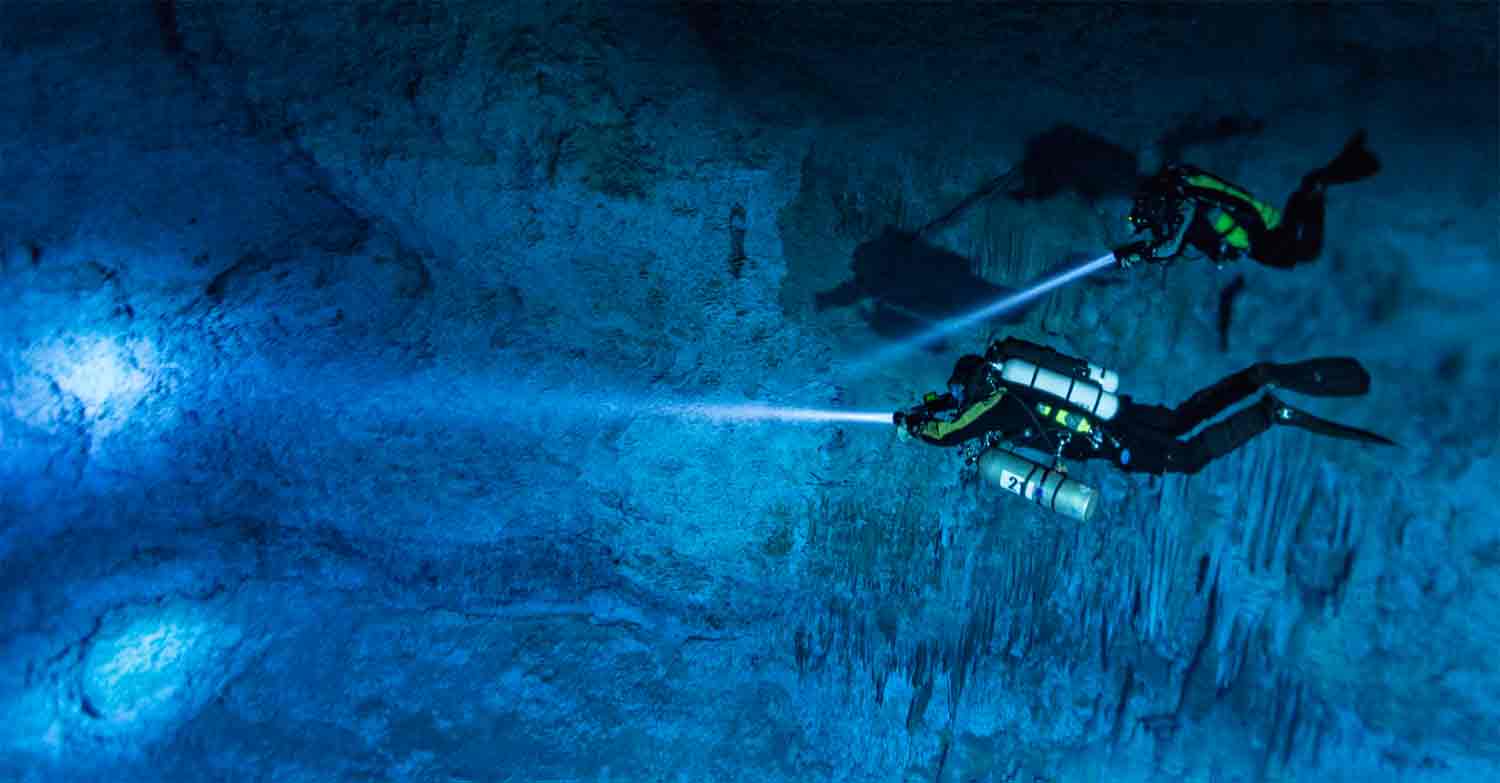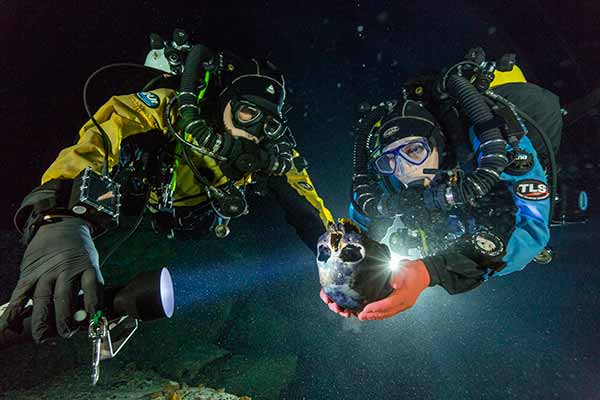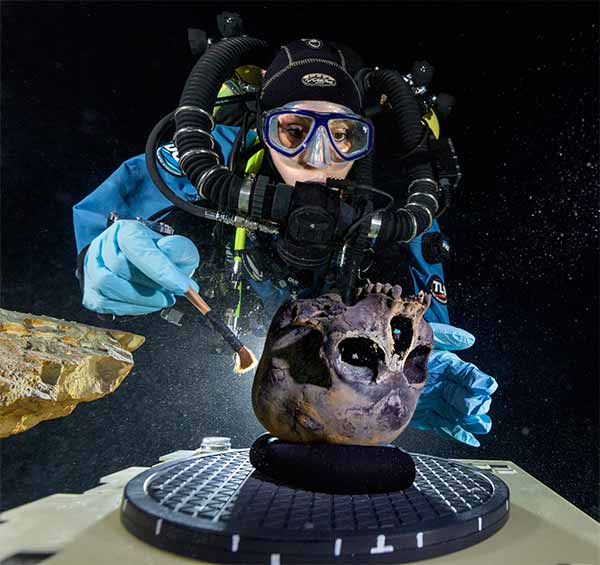CISA3 Researchers to Document Underwater Cave, Paleoamerican Remains
Published Date
By:
- Tiffany Fox
Share This:
Article Content

Divers Susan Bird and Alberto Nava search the walls of Hoyo Negro, an underwater cave on Mexico’s Yucatán Peninsula where the remains of “Naia,” a 12,000- to 13,000-year-old teenage girl, were found.. Photos by Paul Nicklen/National Geographic.
When exploratory divers discovered the underwater Mexican cave site known as Hoyo Negro, the conditions of the cave were so pristine and stable, says archaeologist Dominique Rissolo, “it looked like no one had ever exhaled a breath there.”

Diver Susan Bird working at the bottom of Hoyo Negro, a large dome-shaped underwater cave on Mexico’s Yucatán Peninsula. She carefully brushes the human skull found at the site while her team members take detailed photographs.
But there was evidence that at least one person had been inside the cave before the divers: A Paleoamerican girl nicknamed Naia, who had fallen to her death while presumably collecting water from the cave during the late Pleistocene era, between 13,000 and 12,000 years ago. The divers found her skeleton, as well as the remains of several Ice Age animals, on the cave floor. According to Rissolo and project co-director, James Chatters, it was like the La Brea tar pits without the tar.
This remarkable discovery represents the first and only example of human remains found in direct association with extinct megafauna in the Americas, says Rissolo, who is a visiting scholar at UC San Diego from the Waitt Institute and a research associate at the Scripps Institution of Oceanography. The remains of two gomphotheras (extinct elephant-like creatures), two Shasta ground sloths, a pair of saber-toothed cats and numerous other animals were also found with Naia in the underwater pit, which measures 200 feet in diameter and is located in the far Southeast of the country, on the Yucután Peninsula.
It turns out the excitement wasn’t over for Rissolo and his team, which includes researchers at the Qualcomm Institute’s Center of Interdisciplinary Science for Art, Architecture, and Archaeology (CISA3). Scientists were able to analyze mitochondrial DNA taken from one of Naia’s wisdom teeth to reveal that Naia’s ancestry derived from an Asian genetic lineage only seen in Native Americans. For the first time, Naia’s remains presented hard evidence to support the theory that Native Americans descended from Siberians who crossed into America via a land bridge over the Bering Strait. This analysis was published in a recent issue of Sciencemagazine.
The value of Hoyo Negro as a site of archeological and paleontological significance cannot be overemphasized, and there remains much work to be done to document both the site and the remains found in situ. There’s just one problem: The remoteness and inaccessibility of Hoyo Negro itself. It translates, after all, to “black hole.”
“As archaeologists, many of us don’t have the full complement of skills needed to dive a site like this, so we have to develop a relationship with the cave explorers and include them on our team,” adds Rissolo, who likens the archaeologists to being “stranded on earth” while the divers are “the astronauts getting it done.”
“The scientific dive team only has about an hour of bottom time on every dive because of the limitations of decompression diving, and when you’re diving it’s not conducive for discovering all the different elements of the site,” he explains. “So far the mapping of the cave has been done entirely by the dive team, but a site as complex as Hoyo Negro requires a more sophisticated level of mapping. We need to step up our game.”
That’s where the team at CISA3 comes in. Computer science Ph.D. student Vid Petrovic – a member of the Center’s Integrative Graduate Education and Research Traineeship (IGERT) program in cultural heritage diagnostics – is using photos taken by the scientific dive team to create 3D structure-from-motion (SfM) models of the cave site, and he has used the same technique to recreate Naia’s mandible.

Nava and Bird transport the Hoyo Negro skull to an underwater turntable so that it can be photographed in order to create a 3-D model. (Click image to see larger version)
SfM is an imaging technique that, in this case, uses two-dimensional photographs taken underwater at the cave site. Petrovic tracks and aligns features in the photos (such as corner points) to 'stitch together' and reconstruct the objects digitally in 3D.
Rissolo says that given the proper lighting, camera set-up and protocols, SfM is a relatively straightforward and cost-effective imaging and visualization method, especially for documenting archaeological sites that are not easily accessible or are threatened with destruction, either natural or human-derived.
CISA3 Director Falko Kuester, a professor of visualization and virtual reality at the Qualcomm Institute, points out that much of the work to visualize the remains is happening not at the site, nor even in Mexico, but in UC San Diego’s Atkinson Hall, where CISA3 is located.
"Another interesting twist to the visual exploration of the site, which is taking place in CISA3's advanced virtual reality and rapid prototyping facilities, is that the captured data literally puts discovered artifacts into the palms of the researchers.
“The in-depth post-expedition analysis happens digitally, in the form of 3D models that can be studied interactively and collaboratively, as well as precise physical replicas created on CISA3's 3D printers. Meanwhile, the original artifacts can remain undisturbed where they were originally discovered."
Rissolo notes that CISA3 is especially well placed to document Hoyo Negro because of the work researchers based there have done to digitally record and visualize other archaeological sites, including ruins elsewhere in Mexico and in Greece, Italy and Jordan.
Rissolo’s team at CISA3 also includes one of the divers who originally discovered the cave, Alberto “Beto” Nava, who recently joined the Center as a visiting scholar and co-directs the Hoyo Negro project with Rissolo and Pilar Luna of the Mexican government’s National Institute of Anthropology and History (INAH). In addition to INAH’s leadership and support, the project has received funding from the National Geographic Society, the Archaeological Institute of America and the Waitt Institute.
“Using SfM is a way of taking an underwater archaeological site topside so archaeologists and paleontologists can spend time looking at the relationships between a particular bone and another bone, for example,” explains Rissolo. “If we can document all the artifacts, make a photo map of the bottom of the pit and create a 3D visualization that puts the archaeologists and paleontologists there without ever getting wet, those discoveries and interpretations are made possible.”
Rissolo says he and his team are also considering ways to work with industry and other partners to bring new tools like acoustic mapping and imaging sensors into this plan for visualizing Hoyo Negro.
“Part of this project is about working with students to apply tools and techniques to underwater sites to articulate challenges and priorities of underwater archaeologists,” he explains. “Hoyo Negro is an opportunity for them to think beyond what we currently use and develop a more holistic cyberinfrastructure that creates an environment that allows scientists to go online and make observations and real-time annotations.
“UC San Diego has a strong history of doing that,” he adds. “There’s really no other outfit more capable of meeting that need than CISA3. We couldn’t study sites like Hoyo Negro without them. And let’s remember that this part of Mexico is a scientific frontier and there’s huge potential for discovery there.”
Share This:
Stay in the Know
Keep up with all the latest from UC San Diego. Subscribe to the newsletter today.



